Auditing Report: Ethical Requirements, Procedures, and Materiality
VerifiedAdded on 2022/11/10
|12
|2506
|368
Report
AI Summary
This auditing report provides a comprehensive overview of key elements in auditing, focusing on Australian Auditing and Assurance Standards Board (AUASB) guidelines. It begins with ethical requirements and the importance of auditor independence, referencing ASA 102. The report then discusses preliminary risk assessment, emphasizing the use of prior-period financial statements and audit reports to understand an entity and its environment, as per ASA 315. It highlights the significance of both substantive and analytical procedures (ASA 520) in identifying areas needing special attention within financial statements. The report analyzes financial performance, financial position, and business risks using analytical reviews. Furthermore, it addresses materiality levels (ASA 320) and the impact of auditor independence on audit quality, outlining potential concerns such as inappropriate opinions, manipulation of audit reports, and failure to unearth material misstatements. The report concludes by recommending measures to improve audit quality, including mandatory auditing standards, global standards, cooperation between auditing boards, strict actions for non-compliance, and the maintenance of detailed working papers.
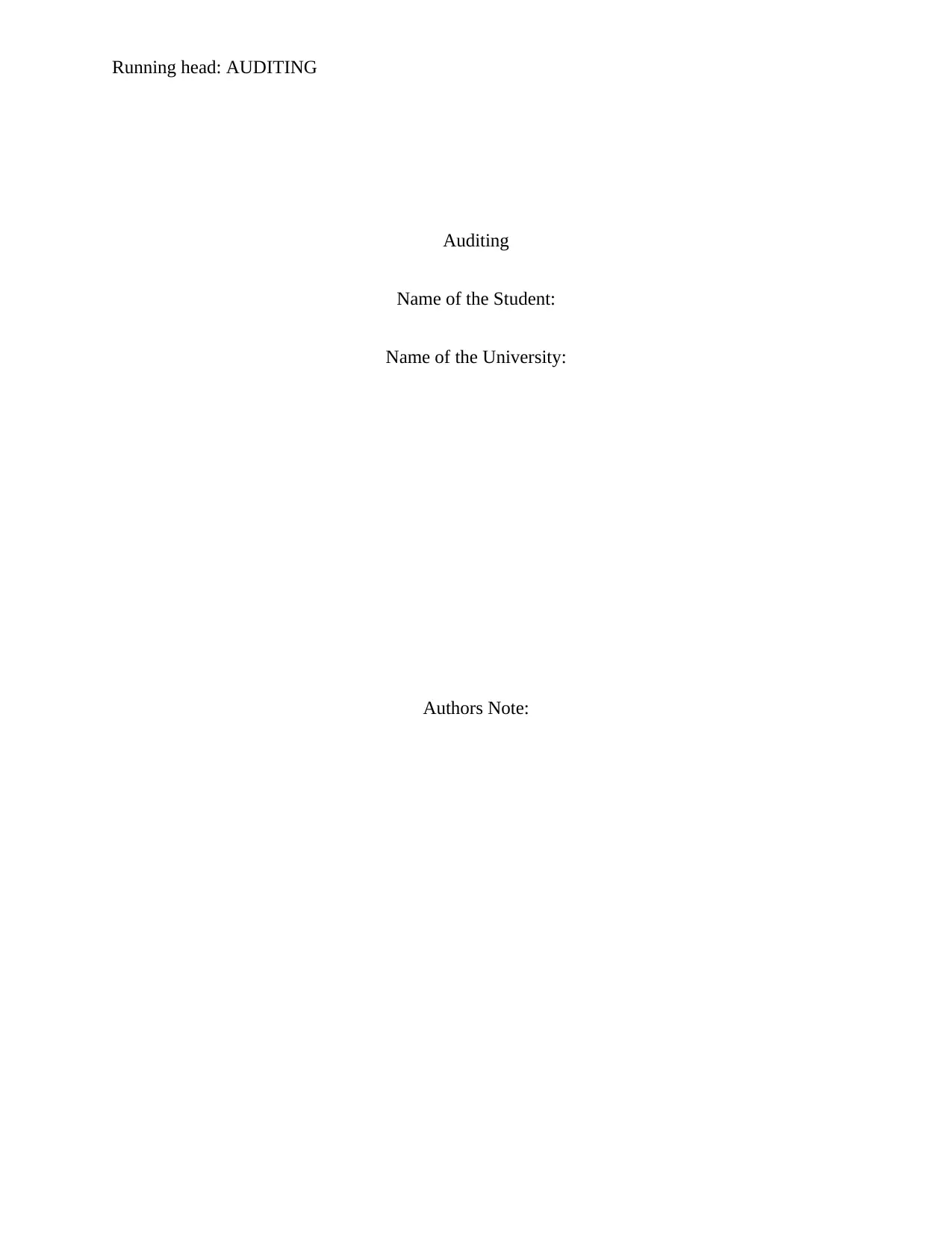
Running head: AUDITING
Auditing
Name of the Student:
Name of the University:
Authors Note:
Auditing
Name of the Student:
Name of the University:
Authors Note:
Paraphrase This Document
Need a fresh take? Get an instant paraphrase of this document with our AI Paraphraser
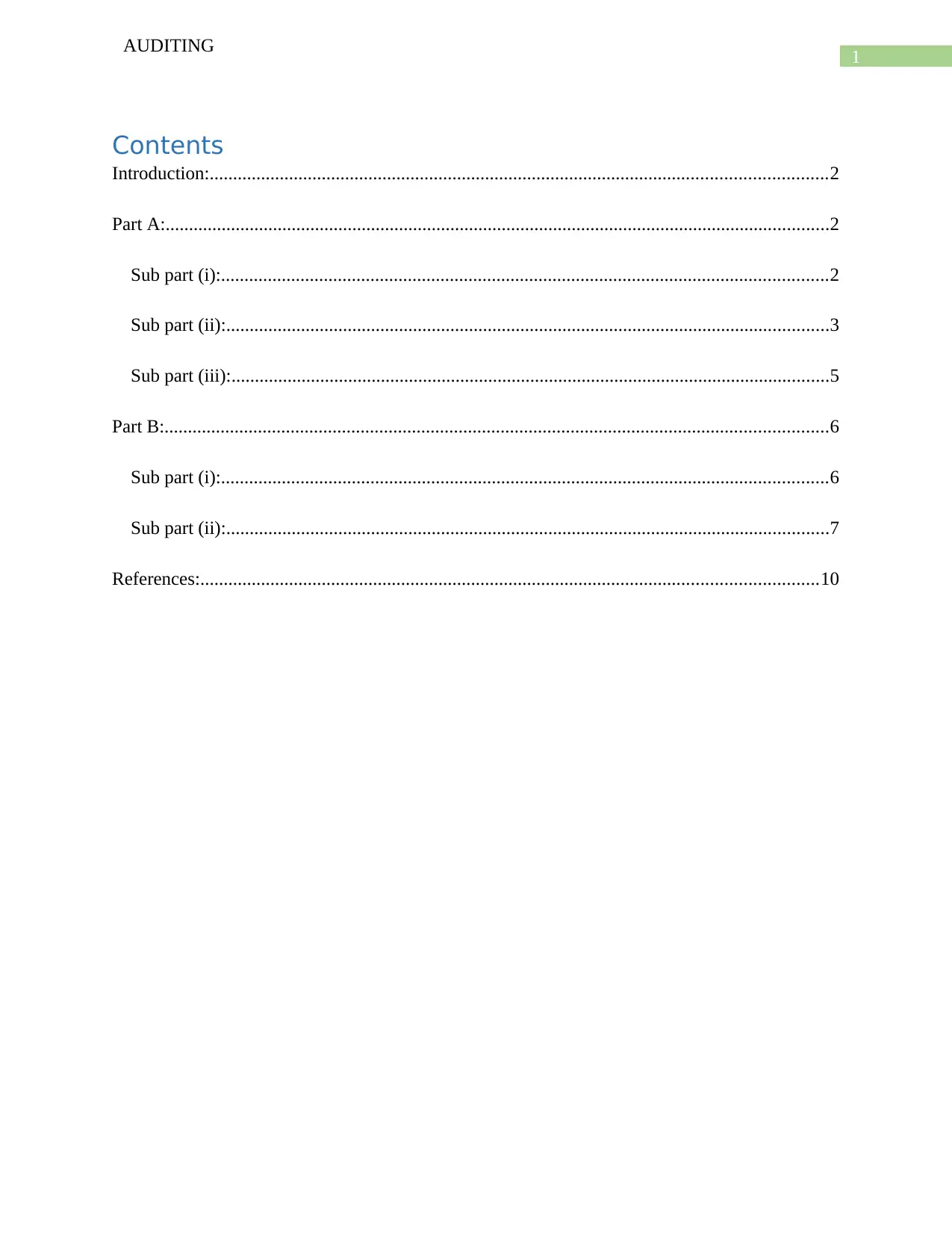
1
AUDITING
Contents
Introduction:....................................................................................................................................2
Part A:..............................................................................................................................................2
Sub part (i):..................................................................................................................................2
Sub part (ii):.................................................................................................................................3
Sub part (iii):................................................................................................................................5
Part B:..............................................................................................................................................6
Sub part (i):..................................................................................................................................6
Sub part (ii):.................................................................................................................................7
References:....................................................................................................................................10
AUDITING
Contents
Introduction:....................................................................................................................................2
Part A:..............................................................................................................................................2
Sub part (i):..................................................................................................................................2
Sub part (ii):.................................................................................................................................3
Sub part (iii):................................................................................................................................5
Part B:..............................................................................................................................................6
Sub part (i):..................................................................................................................................6
Sub part (ii):.................................................................................................................................7
References:....................................................................................................................................10
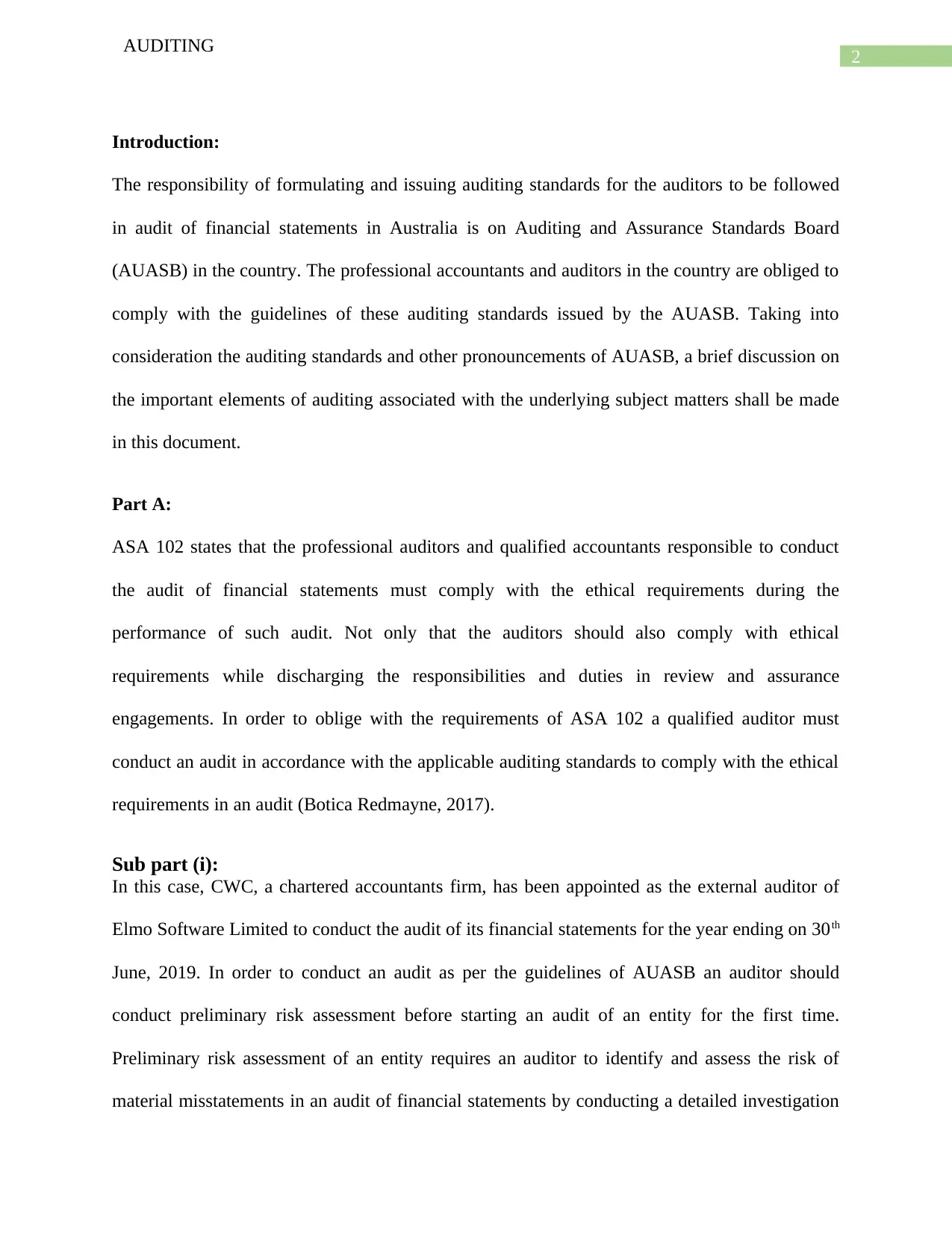
2
AUDITING
Introduction:
The responsibility of formulating and issuing auditing standards for the auditors to be followed
in audit of financial statements in Australia is on Auditing and Assurance Standards Board
(AUASB) in the country. The professional accountants and auditors in the country are obliged to
comply with the guidelines of these auditing standards issued by the AUASB. Taking into
consideration the auditing standards and other pronouncements of AUASB, a brief discussion on
the important elements of auditing associated with the underlying subject matters shall be made
in this document.
Part A:
ASA 102 states that the professional auditors and qualified accountants responsible to conduct
the audit of financial statements must comply with the ethical requirements during the
performance of such audit. Not only that the auditors should also comply with ethical
requirements while discharging the responsibilities and duties in review and assurance
engagements. In order to oblige with the requirements of ASA 102 a qualified auditor must
conduct an audit in accordance with the applicable auditing standards to comply with the ethical
requirements in an audit (Botica Redmayne, 2017).
Sub part (i):
In this case, CWC, a chartered accountants firm, has been appointed as the external auditor of
Elmo Software Limited to conduct the audit of its financial statements for the year ending on 30th
June, 2019. In order to conduct an audit as per the guidelines of AUASB an auditor should
conduct preliminary risk assessment before starting an audit of an entity for the first time.
Preliminary risk assessment of an entity requires an auditor to identify and assess the risk of
material misstatements in an audit of financial statements by conducting a detailed investigation
AUDITING
Introduction:
The responsibility of formulating and issuing auditing standards for the auditors to be followed
in audit of financial statements in Australia is on Auditing and Assurance Standards Board
(AUASB) in the country. The professional accountants and auditors in the country are obliged to
comply with the guidelines of these auditing standards issued by the AUASB. Taking into
consideration the auditing standards and other pronouncements of AUASB, a brief discussion on
the important elements of auditing associated with the underlying subject matters shall be made
in this document.
Part A:
ASA 102 states that the professional auditors and qualified accountants responsible to conduct
the audit of financial statements must comply with the ethical requirements during the
performance of such audit. Not only that the auditors should also comply with ethical
requirements while discharging the responsibilities and duties in review and assurance
engagements. In order to oblige with the requirements of ASA 102 a qualified auditor must
conduct an audit in accordance with the applicable auditing standards to comply with the ethical
requirements in an audit (Botica Redmayne, 2017).
Sub part (i):
In this case, CWC, a chartered accountants firm, has been appointed as the external auditor of
Elmo Software Limited to conduct the audit of its financial statements for the year ending on 30th
June, 2019. In order to conduct an audit as per the guidelines of AUASB an auditor should
conduct preliminary risk assessment before starting an audit of an entity for the first time.
Preliminary risk assessment of an entity requires an auditor to identify and assess the risk of
material misstatements in an audit of financial statements by conducting a detailed investigation
⊘ This is a preview!⊘
Do you want full access?
Subscribe today to unlock all pages.

Trusted by 1+ million students worldwide
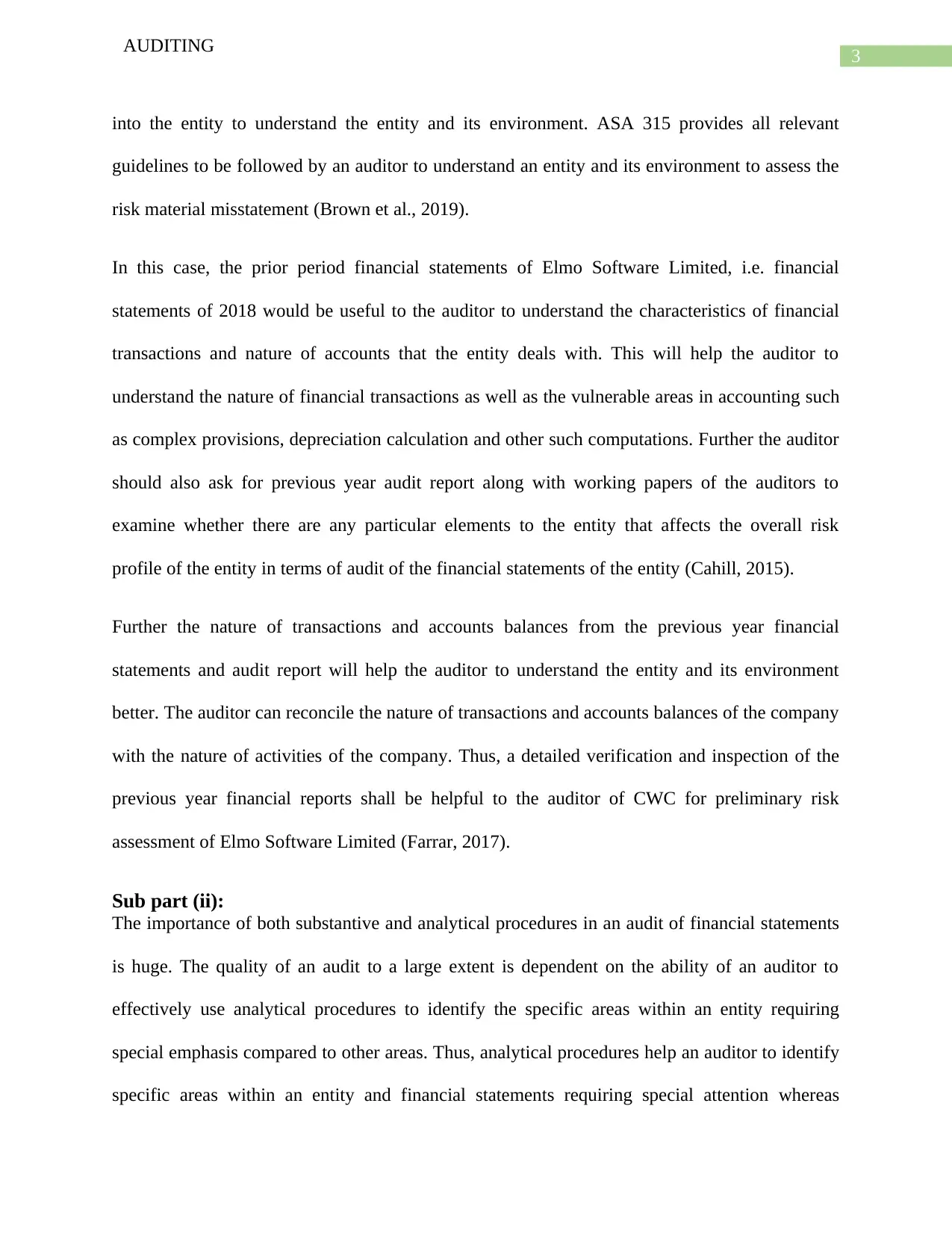
3
AUDITING
into the entity to understand the entity and its environment. ASA 315 provides all relevant
guidelines to be followed by an auditor to understand an entity and its environment to assess the
risk material misstatement (Brown et al., 2019).
In this case, the prior period financial statements of Elmo Software Limited, i.e. financial
statements of 2018 would be useful to the auditor to understand the characteristics of financial
transactions and nature of accounts that the entity deals with. This will help the auditor to
understand the nature of financial transactions as well as the vulnerable areas in accounting such
as complex provisions, depreciation calculation and other such computations. Further the auditor
should also ask for previous year audit report along with working papers of the auditors to
examine whether there are any particular elements to the entity that affects the overall risk
profile of the entity in terms of audit of the financial statements of the entity (Cahill, 2015).
Further the nature of transactions and accounts balances from the previous year financial
statements and audit report will help the auditor to understand the entity and its environment
better. The auditor can reconcile the nature of transactions and accounts balances of the company
with the nature of activities of the company. Thus, a detailed verification and inspection of the
previous year financial reports shall be helpful to the auditor of CWC for preliminary risk
assessment of Elmo Software Limited (Farrar, 2017).
Sub part (ii):
The importance of both substantive and analytical procedures in an audit of financial statements
is huge. The quality of an audit to a large extent is dependent on the ability of an auditor to
effectively use analytical procedures to identify the specific areas within an entity requiring
special emphasis compared to other areas. Thus, analytical procedures help an auditor to identify
specific areas within an entity and financial statements requiring special attention whereas
AUDITING
into the entity to understand the entity and its environment. ASA 315 provides all relevant
guidelines to be followed by an auditor to understand an entity and its environment to assess the
risk material misstatement (Brown et al., 2019).
In this case, the prior period financial statements of Elmo Software Limited, i.e. financial
statements of 2018 would be useful to the auditor to understand the characteristics of financial
transactions and nature of accounts that the entity deals with. This will help the auditor to
understand the nature of financial transactions as well as the vulnerable areas in accounting such
as complex provisions, depreciation calculation and other such computations. Further the auditor
should also ask for previous year audit report along with working papers of the auditors to
examine whether there are any particular elements to the entity that affects the overall risk
profile of the entity in terms of audit of the financial statements of the entity (Cahill, 2015).
Further the nature of transactions and accounts balances from the previous year financial
statements and audit report will help the auditor to understand the entity and its environment
better. The auditor can reconcile the nature of transactions and accounts balances of the company
with the nature of activities of the company. Thus, a detailed verification and inspection of the
previous year financial reports shall be helpful to the auditor of CWC for preliminary risk
assessment of Elmo Software Limited (Farrar, 2017).
Sub part (ii):
The importance of both substantive and analytical procedures in an audit of financial statements
is huge. The quality of an audit to a large extent is dependent on the ability of an auditor to
effectively use analytical procedures to identify the specific areas within an entity requiring
special emphasis compared to other areas. Thus, analytical procedures help an auditor to identify
specific areas within an entity and financial statements requiring special attention whereas
Paraphrase This Document
Need a fresh take? Get an instant paraphrase of this document with our AI Paraphraser
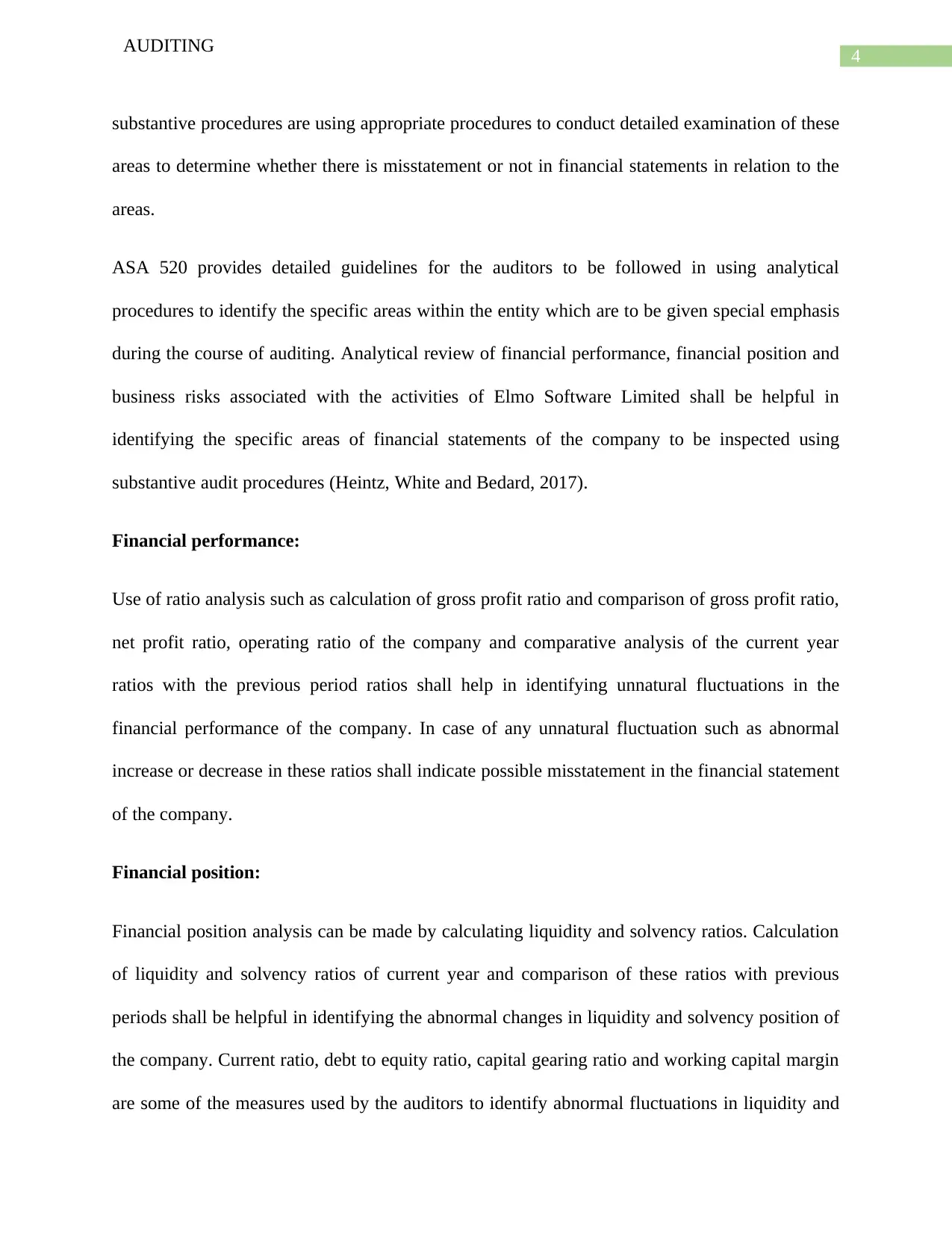
4
AUDITING
substantive procedures are using appropriate procedures to conduct detailed examination of these
areas to determine whether there is misstatement or not in financial statements in relation to the
areas.
ASA 520 provides detailed guidelines for the auditors to be followed in using analytical
procedures to identify the specific areas within the entity which are to be given special emphasis
during the course of auditing. Analytical review of financial performance, financial position and
business risks associated with the activities of Elmo Software Limited shall be helpful in
identifying the specific areas of financial statements of the company to be inspected using
substantive audit procedures (Heintz, White and Bedard, 2017).
Financial performance:
Use of ratio analysis such as calculation of gross profit ratio and comparison of gross profit ratio,
net profit ratio, operating ratio of the company and comparative analysis of the current year
ratios with the previous period ratios shall help in identifying unnatural fluctuations in the
financial performance of the company. In case of any unnatural fluctuation such as abnormal
increase or decrease in these ratios shall indicate possible misstatement in the financial statement
of the company.
Financial position:
Financial position analysis can be made by calculating liquidity and solvency ratios. Calculation
of liquidity and solvency ratios of current year and comparison of these ratios with previous
periods shall be helpful in identifying the abnormal changes in liquidity and solvency position of
the company. Current ratio, debt to equity ratio, capital gearing ratio and working capital margin
are some of the measures used by the auditors to identify abnormal fluctuations in liquidity and
AUDITING
substantive procedures are using appropriate procedures to conduct detailed examination of these
areas to determine whether there is misstatement or not in financial statements in relation to the
areas.
ASA 520 provides detailed guidelines for the auditors to be followed in using analytical
procedures to identify the specific areas within the entity which are to be given special emphasis
during the course of auditing. Analytical review of financial performance, financial position and
business risks associated with the activities of Elmo Software Limited shall be helpful in
identifying the specific areas of financial statements of the company to be inspected using
substantive audit procedures (Heintz, White and Bedard, 2017).
Financial performance:
Use of ratio analysis such as calculation of gross profit ratio and comparison of gross profit ratio,
net profit ratio, operating ratio of the company and comparative analysis of the current year
ratios with the previous period ratios shall help in identifying unnatural fluctuations in the
financial performance of the company. In case of any unnatural fluctuation such as abnormal
increase or decrease in these ratios shall indicate possible misstatement in the financial statement
of the company.
Financial position:
Financial position analysis can be made by calculating liquidity and solvency ratios. Calculation
of liquidity and solvency ratios of current year and comparison of these ratios with previous
periods shall be helpful in identifying the abnormal changes in liquidity and solvency position of
the company. Current ratio, debt to equity ratio, capital gearing ratio and working capital margin
are some of the measures used by the auditors to identify abnormal fluctuations in liquidity and
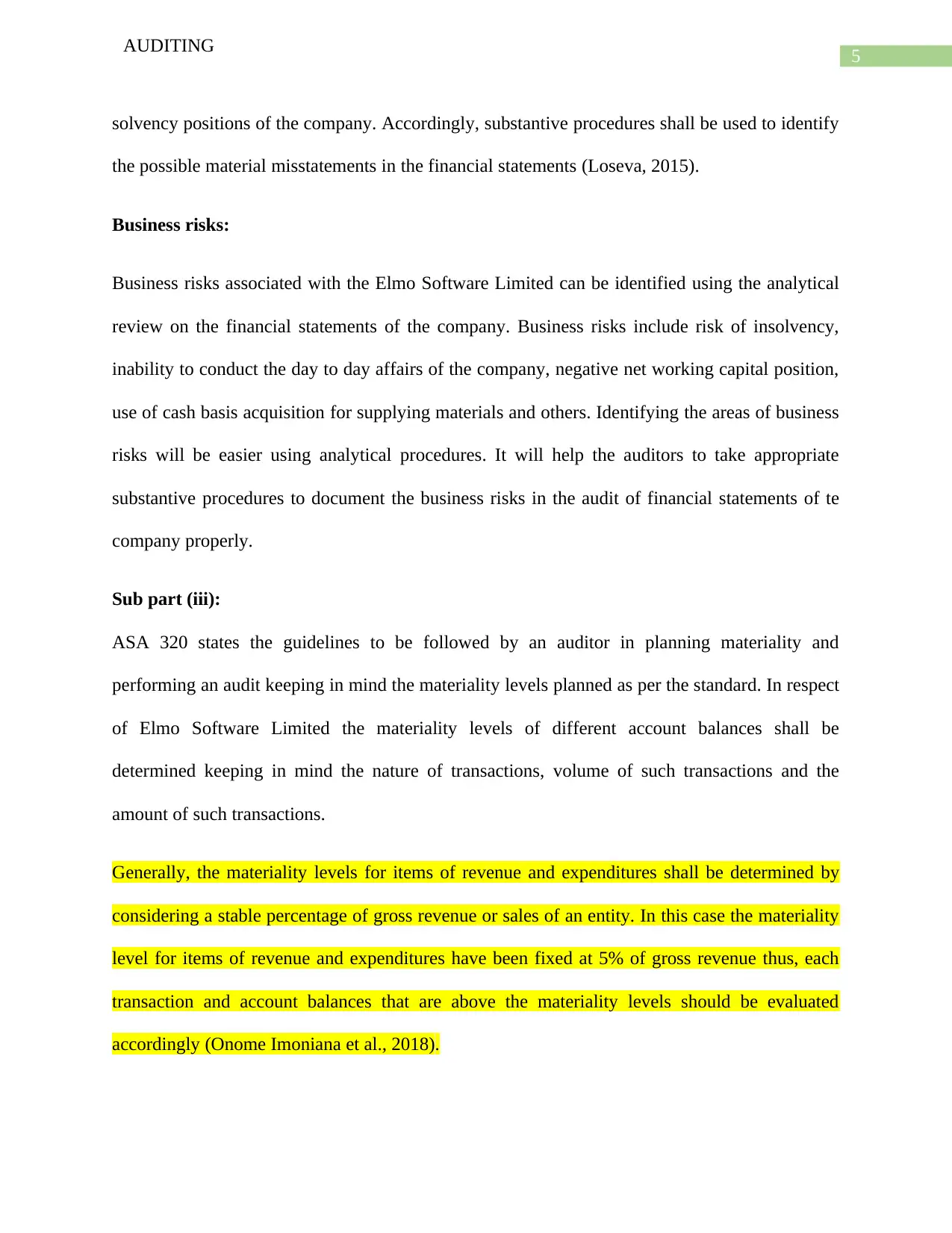
5
AUDITING
solvency positions of the company. Accordingly, substantive procedures shall be used to identify
the possible material misstatements in the financial statements (Loseva, 2015).
Business risks:
Business risks associated with the Elmo Software Limited can be identified using the analytical
review on the financial statements of the company. Business risks include risk of insolvency,
inability to conduct the day to day affairs of the company, negative net working capital position,
use of cash basis acquisition for supplying materials and others. Identifying the areas of business
risks will be easier using analytical procedures. It will help the auditors to take appropriate
substantive procedures to document the business risks in the audit of financial statements of te
company properly.
Sub part (iii):
ASA 320 states the guidelines to be followed by an auditor in planning materiality and
performing an audit keeping in mind the materiality levels planned as per the standard. In respect
of Elmo Software Limited the materiality levels of different account balances shall be
determined keeping in mind the nature of transactions, volume of such transactions and the
amount of such transactions.
Generally, the materiality levels for items of revenue and expenditures shall be determined by
considering a stable percentage of gross revenue or sales of an entity. In this case the materiality
level for items of revenue and expenditures have been fixed at 5% of gross revenue thus, each
transaction and account balances that are above the materiality levels should be evaluated
accordingly (Onome Imoniana et al., 2018).
AUDITING
solvency positions of the company. Accordingly, substantive procedures shall be used to identify
the possible material misstatements in the financial statements (Loseva, 2015).
Business risks:
Business risks associated with the Elmo Software Limited can be identified using the analytical
review on the financial statements of the company. Business risks include risk of insolvency,
inability to conduct the day to day affairs of the company, negative net working capital position,
use of cash basis acquisition for supplying materials and others. Identifying the areas of business
risks will be easier using analytical procedures. It will help the auditors to take appropriate
substantive procedures to document the business risks in the audit of financial statements of te
company properly.
Sub part (iii):
ASA 320 states the guidelines to be followed by an auditor in planning materiality and
performing an audit keeping in mind the materiality levels planned as per the standard. In respect
of Elmo Software Limited the materiality levels of different account balances shall be
determined keeping in mind the nature of transactions, volume of such transactions and the
amount of such transactions.
Generally, the materiality levels for items of revenue and expenditures shall be determined by
considering a stable percentage of gross revenue or sales of an entity. In this case the materiality
level for items of revenue and expenditures have been fixed at 5% of gross revenue thus, each
transaction and account balances that are above the materiality levels should be evaluated
accordingly (Onome Imoniana et al., 2018).
⊘ This is a preview!⊘
Do you want full access?
Subscribe today to unlock all pages.

Trusted by 1+ million students worldwide
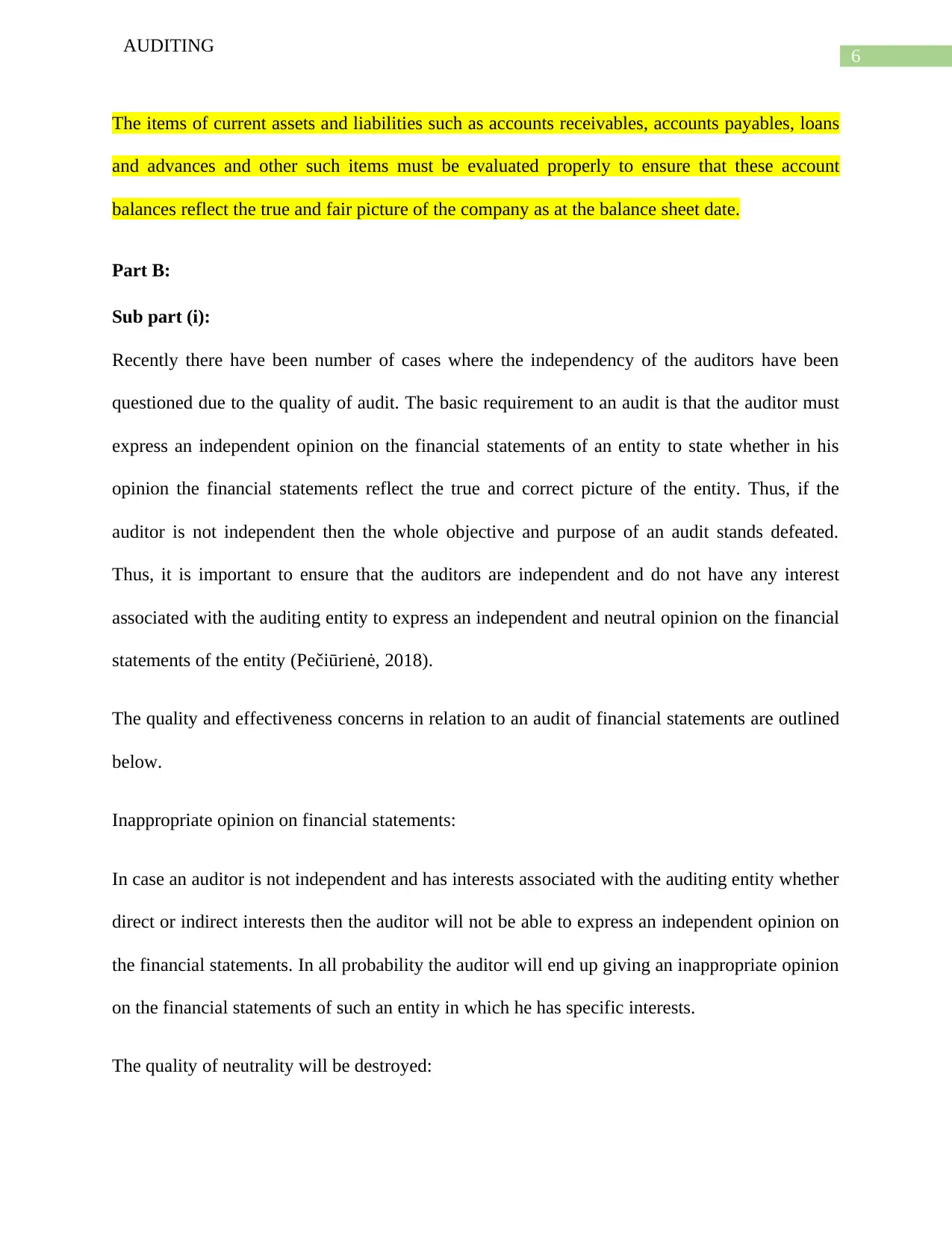
6
AUDITING
The items of current assets and liabilities such as accounts receivables, accounts payables, loans
and advances and other such items must be evaluated properly to ensure that these account
balances reflect the true and fair picture of the company as at the balance sheet date.
Part B:
Sub part (i):
Recently there have been number of cases where the independency of the auditors have been
questioned due to the quality of audit. The basic requirement to an audit is that the auditor must
express an independent opinion on the financial statements of an entity to state whether in his
opinion the financial statements reflect the true and correct picture of the entity. Thus, if the
auditor is not independent then the whole objective and purpose of an audit stands defeated.
Thus, it is important to ensure that the auditors are independent and do not have any interest
associated with the auditing entity to express an independent and neutral opinion on the financial
statements of the entity (Pečiūrienė, 2018).
The quality and effectiveness concerns in relation to an audit of financial statements are outlined
below.
Inappropriate opinion on financial statements:
In case an auditor is not independent and has interests associated with the auditing entity whether
direct or indirect interests then the auditor will not be able to express an independent opinion on
the financial statements. In all probability the auditor will end up giving an inappropriate opinion
on the financial statements of such an entity in which he has specific interests.
The quality of neutrality will be destroyed:
AUDITING
The items of current assets and liabilities such as accounts receivables, accounts payables, loans
and advances and other such items must be evaluated properly to ensure that these account
balances reflect the true and fair picture of the company as at the balance sheet date.
Part B:
Sub part (i):
Recently there have been number of cases where the independency of the auditors have been
questioned due to the quality of audit. The basic requirement to an audit is that the auditor must
express an independent opinion on the financial statements of an entity to state whether in his
opinion the financial statements reflect the true and correct picture of the entity. Thus, if the
auditor is not independent then the whole objective and purpose of an audit stands defeated.
Thus, it is important to ensure that the auditors are independent and do not have any interest
associated with the auditing entity to express an independent and neutral opinion on the financial
statements of the entity (Pečiūrienė, 2018).
The quality and effectiveness concerns in relation to an audit of financial statements are outlined
below.
Inappropriate opinion on financial statements:
In case an auditor is not independent and has interests associated with the auditing entity whether
direct or indirect interests then the auditor will not be able to express an independent opinion on
the financial statements. In all probability the auditor will end up giving an inappropriate opinion
on the financial statements of such an entity in which he has specific interests.
The quality of neutrality will be destroyed:
Paraphrase This Document
Need a fresh take? Get an instant paraphrase of this document with our AI Paraphraser
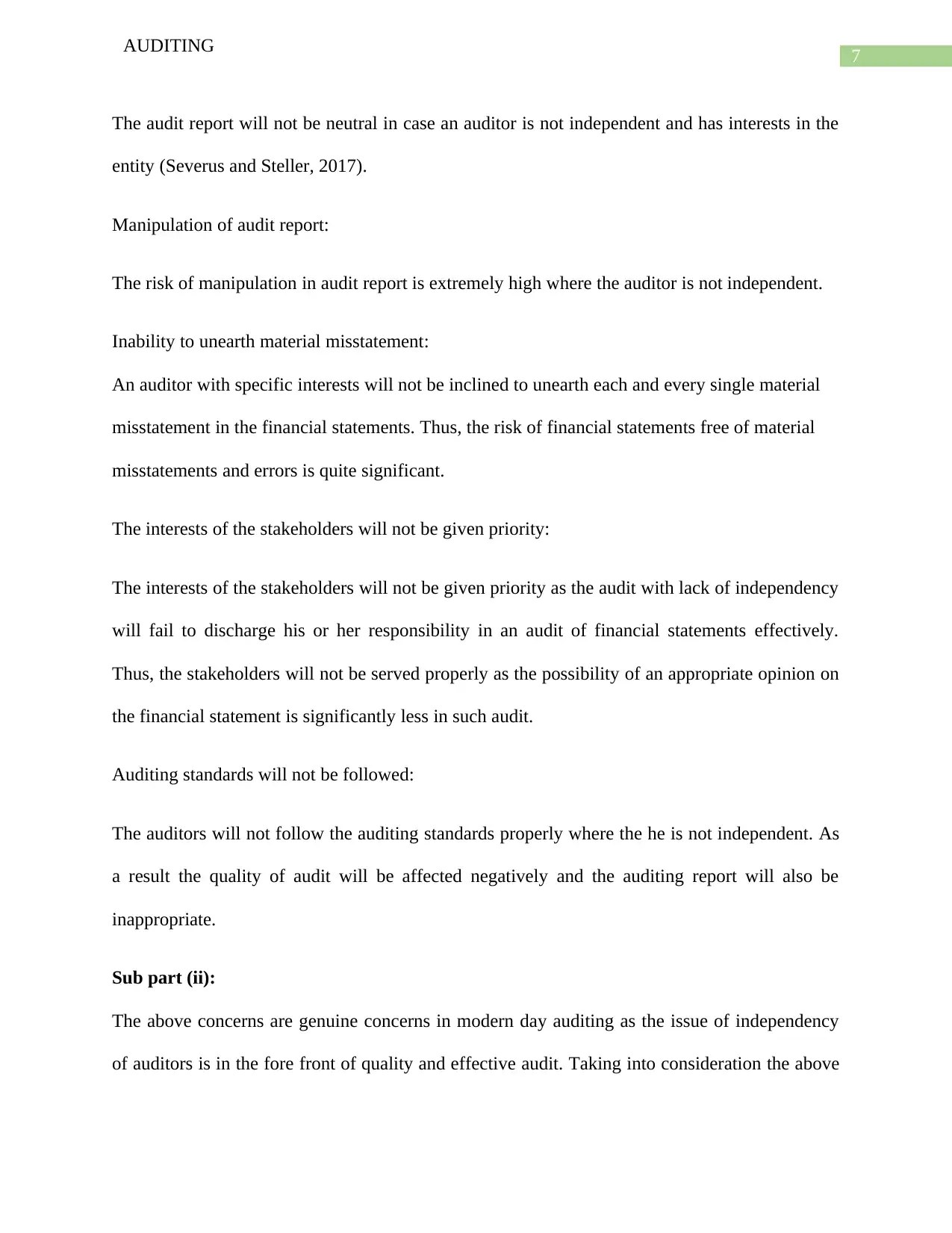
7
AUDITING
The audit report will not be neutral in case an auditor is not independent and has interests in the
entity (Severus and Steller, 2017).
Manipulation of audit report:
The risk of manipulation in audit report is extremely high where the auditor is not independent.
Inability to unearth material misstatement:
An auditor with specific interests will not be inclined to unearth each and every single material
misstatement in the financial statements. Thus, the risk of financial statements free of material
misstatements and errors is quite significant.
The interests of the stakeholders will not be given priority:
The interests of the stakeholders will not be given priority as the audit with lack of independency
will fail to discharge his or her responsibility in an audit of financial statements effectively.
Thus, the stakeholders will not be served properly as the possibility of an appropriate opinion on
the financial statement is significantly less in such audit.
Auditing standards will not be followed:
The auditors will not follow the auditing standards properly where the he is not independent. As
a result the quality of audit will be affected negatively and the auditing report will also be
inappropriate.
Sub part (ii):
The above concerns are genuine concerns in modern day auditing as the issue of independency
of auditors is in the fore front of quality and effective audit. Taking into consideration the above
AUDITING
The audit report will not be neutral in case an auditor is not independent and has interests in the
entity (Severus and Steller, 2017).
Manipulation of audit report:
The risk of manipulation in audit report is extremely high where the auditor is not independent.
Inability to unearth material misstatement:
An auditor with specific interests will not be inclined to unearth each and every single material
misstatement in the financial statements. Thus, the risk of financial statements free of material
misstatements and errors is quite significant.
The interests of the stakeholders will not be given priority:
The interests of the stakeholders will not be given priority as the audit with lack of independency
will fail to discharge his or her responsibility in an audit of financial statements effectively.
Thus, the stakeholders will not be served properly as the possibility of an appropriate opinion on
the financial statement is significantly less in such audit.
Auditing standards will not be followed:
The auditors will not follow the auditing standards properly where the he is not independent. As
a result the quality of audit will be affected negatively and the auditing report will also be
inappropriate.
Sub part (ii):
The above concerns are genuine concerns in modern day auditing as the issue of independency
of auditors is in the fore front of quality and effective audit. Taking into consideration the above
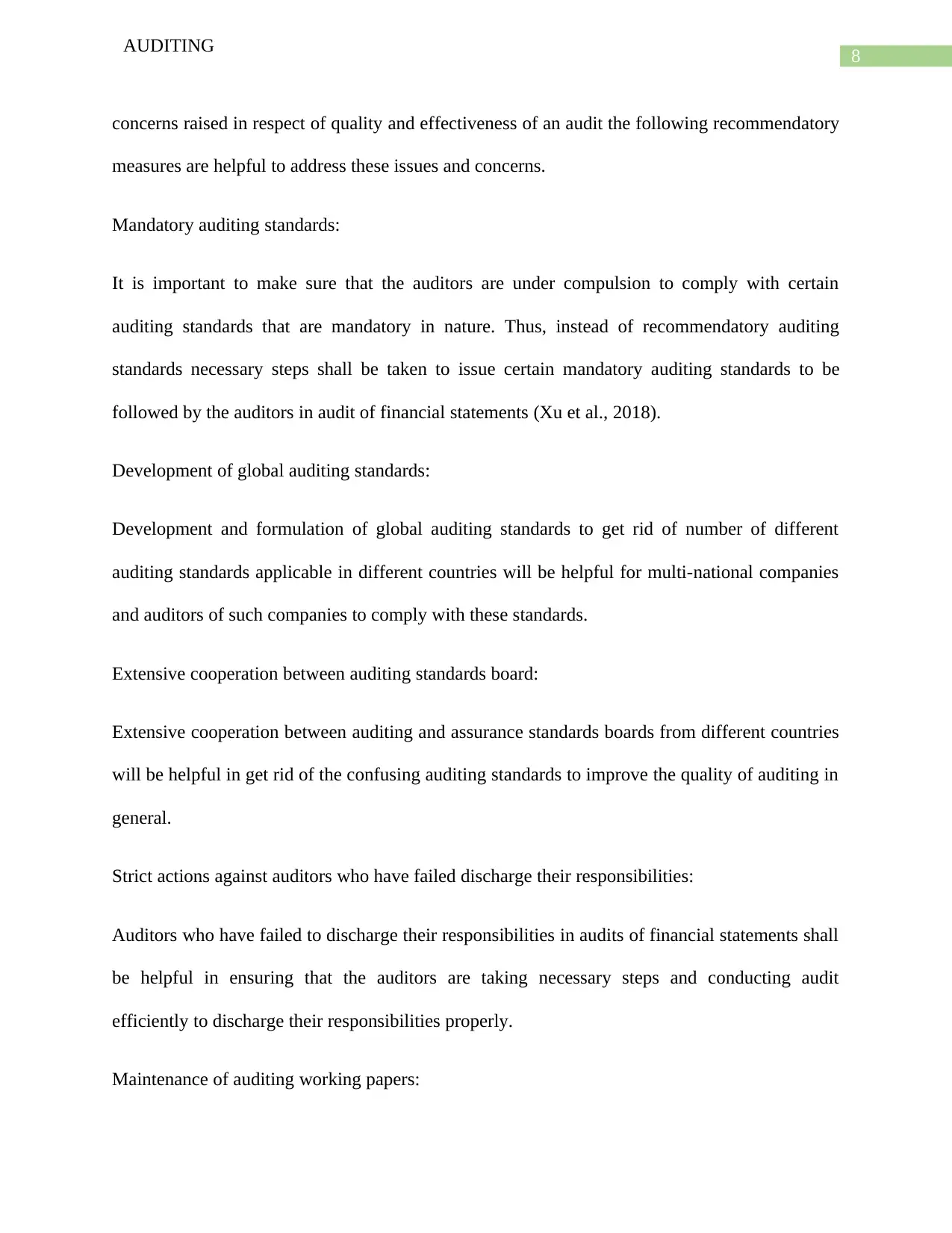
8
AUDITING
concerns raised in respect of quality and effectiveness of an audit the following recommendatory
measures are helpful to address these issues and concerns.
Mandatory auditing standards:
It is important to make sure that the auditors are under compulsion to comply with certain
auditing standards that are mandatory in nature. Thus, instead of recommendatory auditing
standards necessary steps shall be taken to issue certain mandatory auditing standards to be
followed by the auditors in audit of financial statements (Xu et al., 2018).
Development of global auditing standards:
Development and formulation of global auditing standards to get rid of number of different
auditing standards applicable in different countries will be helpful for multi-national companies
and auditors of such companies to comply with these standards.
Extensive cooperation between auditing standards board:
Extensive cooperation between auditing and assurance standards boards from different countries
will be helpful in get rid of the confusing auditing standards to improve the quality of auditing in
general.
Strict actions against auditors who have failed discharge their responsibilities:
Auditors who have failed to discharge their responsibilities in audits of financial statements shall
be helpful in ensuring that the auditors are taking necessary steps and conducting audit
efficiently to discharge their responsibilities properly.
Maintenance of auditing working papers:
AUDITING
concerns raised in respect of quality and effectiveness of an audit the following recommendatory
measures are helpful to address these issues and concerns.
Mandatory auditing standards:
It is important to make sure that the auditors are under compulsion to comply with certain
auditing standards that are mandatory in nature. Thus, instead of recommendatory auditing
standards necessary steps shall be taken to issue certain mandatory auditing standards to be
followed by the auditors in audit of financial statements (Xu et al., 2018).
Development of global auditing standards:
Development and formulation of global auditing standards to get rid of number of different
auditing standards applicable in different countries will be helpful for multi-national companies
and auditors of such companies to comply with these standards.
Extensive cooperation between auditing standards board:
Extensive cooperation between auditing and assurance standards boards from different countries
will be helpful in get rid of the confusing auditing standards to improve the quality of auditing in
general.
Strict actions against auditors who have failed discharge their responsibilities:
Auditors who have failed to discharge their responsibilities in audits of financial statements shall
be helpful in ensuring that the auditors are taking necessary steps and conducting audit
efficiently to discharge their responsibilities properly.
Maintenance of auditing working papers:
⊘ This is a preview!⊘
Do you want full access?
Subscribe today to unlock all pages.

Trusted by 1+ million students worldwide
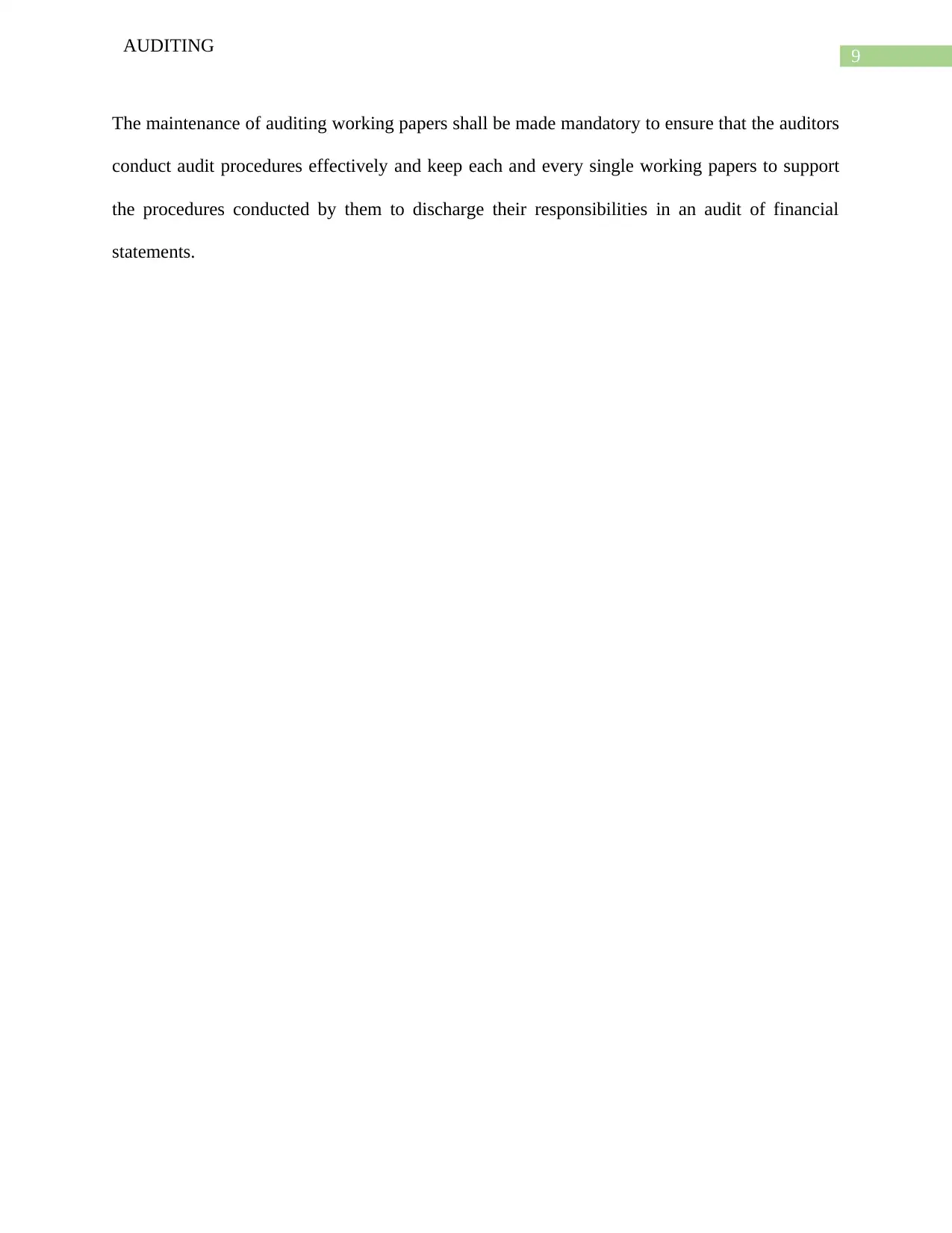
9
AUDITING
The maintenance of auditing working papers shall be made mandatory to ensure that the auditors
conduct audit procedures effectively and keep each and every single working papers to support
the procedures conducted by them to discharge their responsibilities in an audit of financial
statements.
AUDITING
The maintenance of auditing working papers shall be made mandatory to ensure that the auditors
conduct audit procedures effectively and keep each and every single working papers to support
the procedures conducted by them to discharge their responsibilities in an audit of financial
statements.
Paraphrase This Document
Need a fresh take? Get an instant paraphrase of this document with our AI Paraphraser
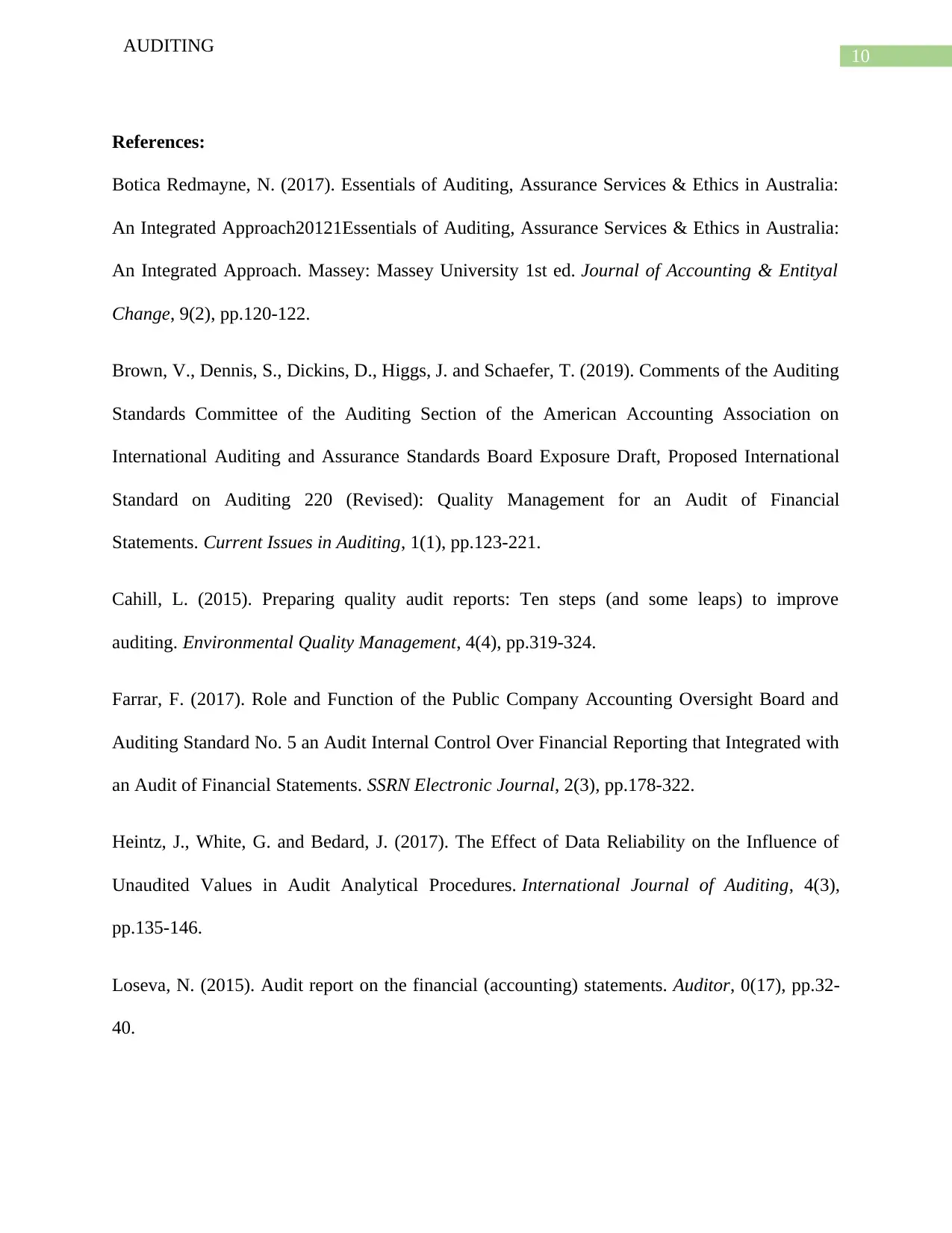
10
AUDITING
References:
Botica Redmayne, N. (2017). Essentials of Auditing, Assurance Services & Ethics in Australia:
An Integrated Approach20121Essentials of Auditing, Assurance Services & Ethics in Australia:
An Integrated Approach. Massey: Massey University 1st ed. Journal of Accounting & Entityal
Change, 9(2), pp.120-122.
Brown, V., Dennis, S., Dickins, D., Higgs, J. and Schaefer, T. (2019). Comments of the Auditing
Standards Committee of the Auditing Section of the American Accounting Association on
International Auditing and Assurance Standards Board Exposure Draft, Proposed International
Standard on Auditing 220 (Revised): Quality Management for an Audit of Financial
Statements. Current Issues in Auditing, 1(1), pp.123-221.
Cahill, L. (2015). Preparing quality audit reports: Ten steps (and some leaps) to improve
auditing. Environmental Quality Management, 4(4), pp.319-324.
Farrar, F. (2017). Role and Function of the Public Company Accounting Oversight Board and
Auditing Standard No. 5 an Audit Internal Control Over Financial Reporting that Integrated with
an Audit of Financial Statements. SSRN Electronic Journal, 2(3), pp.178-322.
Heintz, J., White, G. and Bedard, J. (2017). The Effect of Data Reliability on the Influence of
Unaudited Values in Audit Analytical Procedures. International Journal of Auditing, 4(3),
pp.135-146.
Loseva, N. (2015). Audit report on the financial (accounting) statements. Auditor, 0(17), pp.32-
40.
AUDITING
References:
Botica Redmayne, N. (2017). Essentials of Auditing, Assurance Services & Ethics in Australia:
An Integrated Approach20121Essentials of Auditing, Assurance Services & Ethics in Australia:
An Integrated Approach. Massey: Massey University 1st ed. Journal of Accounting & Entityal
Change, 9(2), pp.120-122.
Brown, V., Dennis, S., Dickins, D., Higgs, J. and Schaefer, T. (2019). Comments of the Auditing
Standards Committee of the Auditing Section of the American Accounting Association on
International Auditing and Assurance Standards Board Exposure Draft, Proposed International
Standard on Auditing 220 (Revised): Quality Management for an Audit of Financial
Statements. Current Issues in Auditing, 1(1), pp.123-221.
Cahill, L. (2015). Preparing quality audit reports: Ten steps (and some leaps) to improve
auditing. Environmental Quality Management, 4(4), pp.319-324.
Farrar, F. (2017). Role and Function of the Public Company Accounting Oversight Board and
Auditing Standard No. 5 an Audit Internal Control Over Financial Reporting that Integrated with
an Audit of Financial Statements. SSRN Electronic Journal, 2(3), pp.178-322.
Heintz, J., White, G. and Bedard, J. (2017). The Effect of Data Reliability on the Influence of
Unaudited Values in Audit Analytical Procedures. International Journal of Auditing, 4(3),
pp.135-146.
Loseva, N. (2015). Audit report on the financial (accounting) statements. Auditor, 0(17), pp.32-
40.
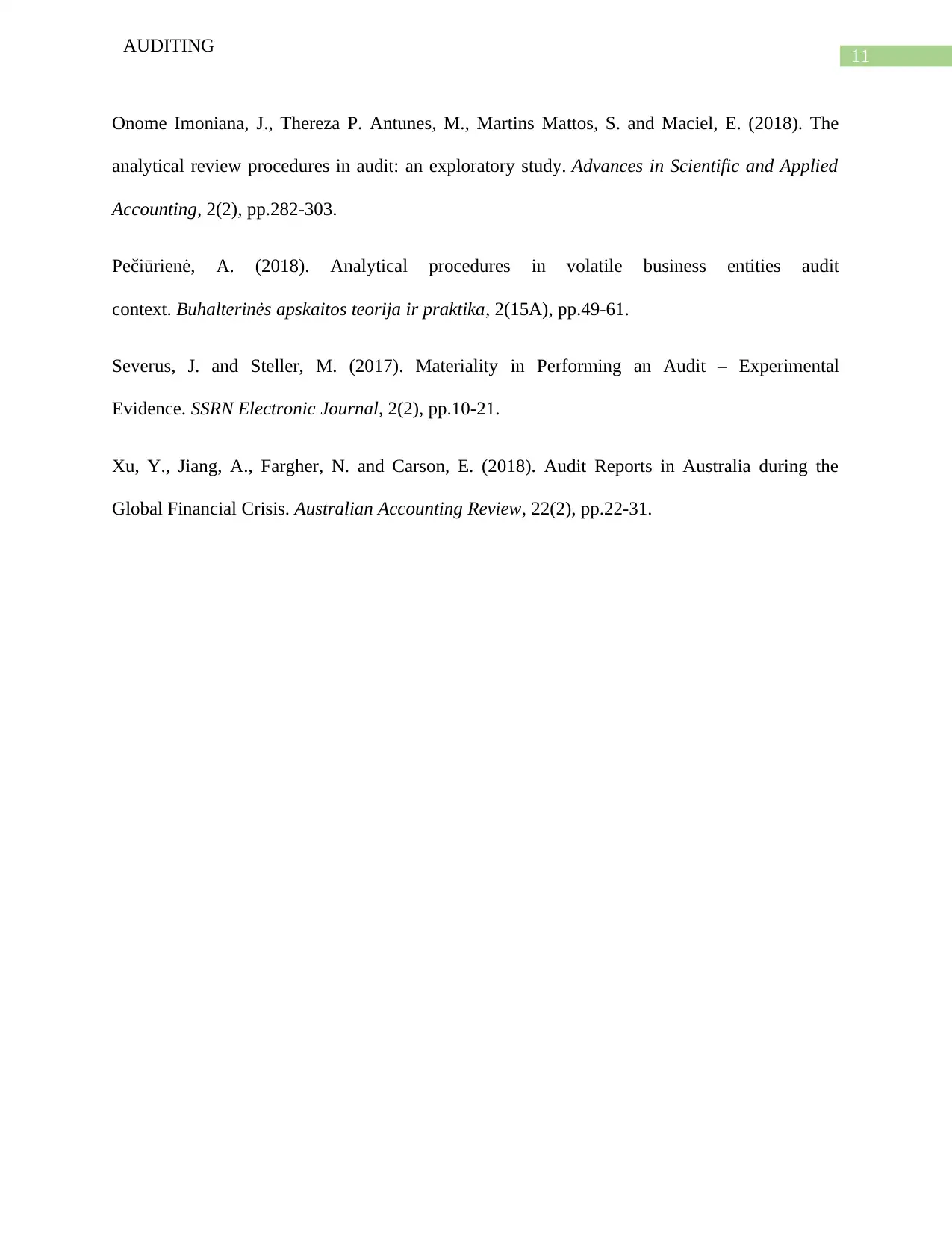
11
AUDITING
Onome Imoniana, J., Thereza P. Antunes, M., Martins Mattos, S. and Maciel, E. (2018). The
analytical review procedures in audit: an exploratory study. Advances in Scientific and Applied
Accounting, 2(2), pp.282-303.
Pečiūrienė, A. (2018). Analytical procedures in volatile business entities audit
context. Buhalterinės apskaitos teorija ir praktika, 2(15A), pp.49-61.
Severus, J. and Steller, M. (2017). Materiality in Performing an Audit – Experimental
Evidence. SSRN Electronic Journal, 2(2), pp.10-21.
Xu, Y., Jiang, A., Fargher, N. and Carson, E. (2018). Audit Reports in Australia during the
Global Financial Crisis. Australian Accounting Review, 22(2), pp.22-31.
AUDITING
Onome Imoniana, J., Thereza P. Antunes, M., Martins Mattos, S. and Maciel, E. (2018). The
analytical review procedures in audit: an exploratory study. Advances in Scientific and Applied
Accounting, 2(2), pp.282-303.
Pečiūrienė, A. (2018). Analytical procedures in volatile business entities audit
context. Buhalterinės apskaitos teorija ir praktika, 2(15A), pp.49-61.
Severus, J. and Steller, M. (2017). Materiality in Performing an Audit – Experimental
Evidence. SSRN Electronic Journal, 2(2), pp.10-21.
Xu, Y., Jiang, A., Fargher, N. and Carson, E. (2018). Audit Reports in Australia during the
Global Financial Crisis. Australian Accounting Review, 22(2), pp.22-31.
⊘ This is a preview!⊘
Do you want full access?
Subscribe today to unlock all pages.

Trusted by 1+ million students worldwide
1 out of 12
Related Documents
Your All-in-One AI-Powered Toolkit for Academic Success.
+13062052269
info@desklib.com
Available 24*7 on WhatsApp / Email
![[object Object]](/_next/static/media/star-bottom.7253800d.svg)
Unlock your academic potential
Copyright © 2020–2025 A2Z Services. All Rights Reserved. Developed and managed by ZUCOL.





